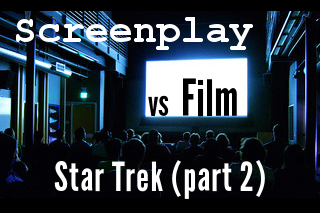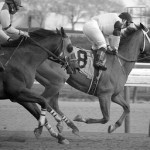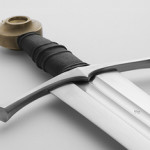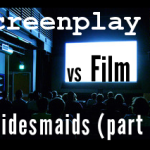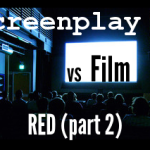Today is part two of the 11 Screenwriting Tips from Star Trek I learned by comparing a shooting script to the version of the 2009 reboot released in theaters. Examining these changes is like getting an inside peek into JJ Abrams’s movie-making process, so it’s well worth the read! Now, onto the tips:
Screenwriting Tip #6: Movies are supposed to make money
When you’re knee deep in screenplay writing trenches, the last thing you’re thinking about is how much it will cost to shoot the scene you’re writing. But that consideration is going to be foremost on the minds of the studio once they purchase your script.
Even movies like Star Trek don’t have a limitless budget. When you become a working screenwriter in Hollywood, you’ll probably be asked to rewrite screenplays in order to trim production costs. You might as well get some practice now…and the difference between the Star Trek shooting script and the Star Trek theatrical version gives us some insight into how to do it.
In the Star Trek shooting script, the villain, Nero, played by a very sullen Eric Bana, was taken prisoner by the Klingons. Even though he was a prisoner, he was still actively pursuing his goal of destroying the Federation. Take a look:
EXT. RURA PENTHE- MINING QUARRY – NIGHT
CONSTANT SHOCKS OF LIGHT as an ALIEN PRISONER — intelligent, bipedal, but with FOUR TERRIFIED EYES — is SLAMMED DOWN onto the wet pavement — a CHOKE STICK SHOVED under his chin — then: VOICES. Brutal, guttural KLINGON —
KLINGON GUARD (O.S.)
(SUBTITLED)
You say they are not yours…
WHIP PAN TO SEE the scary KLINGON GUARDS — four of them — standing above the Alien — chilling MASKS hide their hideous faces — and one holds a FLUORESCENT SET OF PAGES —
KLINGON GUARD (CONT’D)
…these Federation maps we found in your pockets.
And the ALIEN SPEAKS — an UNKNOWN LANGUAGE — all eyes wild:
ALIEN
(SUBTITLED)
I speak the truth. I do.
KLINGON GUARD
Then who are they for?
But the Alien just SHAKES HIS HEAD, afraid — he will not talk. So they GRAB HIM AND YANK HIM UPWARD —
KLINGON GUARD (CONT’D)
You would rather die then tell us?
PUSH IN TIGHT as the Alien finally WHISPERS, terrified:
ALIEN
…NERO!!!
And the Guards look at each other…seemingly with concern…
MOMENTS LATER EIGHT GUARDS WALK TOGETHER — and we PAN WITH THEM to reveal the HORRIFYING EXPANSE THAT IS THE KLINGON PRISON YARD. We realize that the constant shocks of light was LIGHTNING, that apparently never stops here.
A SUPER READS: “RURA PENTHE – KLINGON PRISON ASTEROID”.
And we see they’re heading for a MUSCULAR FIGURE, using a SLEDGE HAMMER, SPLITTING ROCKS, lit brilliantly by the lightning strikes.
BOOM UP to find that it’s NERO. And he stops, SENSING the coming Guards.
And he manages a small smile. And he QUICKLY TURNS to them — THEY ALL STOP, SUDDENLY. Afraid of him. One of them tosses Nero a set of MANACLES. Nero picks them up. Puts them on. And offers his cuffed hands, willingly.
This whole scene takes place on a Klingon prison asteroid, which means that the production crew has to design an entirely new set just for this one scene, a set which will never be utilized again in the movie. Plus, the costume department has to design Klingon clothing, while the make-up department has to transform actors into the trademark Klingon visage.
All of this takes time–and money. But the key objective of the scene–that Nero is determined to overthrow the Federation–can be communicated in a far more budget-friendly way:
INT. NARADA – TORTURE ROOM
On PIKE’S FACE, strapped to a TABLE. Nero looks down upon him.
NERO
You are only the second human I have ever met, face to face. You must have so many questions for me. I only have one for you. I need the subspace frequencies of Starfleet’s border detection grids. Specifically those surrounding Earth.
Pike looks up at him — quiet rage. Then —
PIKE
Christopher Pike — Captain, U.S.S. Enterprise, registry NCC-1701.
NERO
Christopher.
(beat; hardcore)
Answer my question.
Isn’t that much better? (At least for the accountants, if not for the die hard Trekkie fans who’d want to see Klingons onscreen.) By eliminating the scene in the Klingon prison asteroid, none of the story was sacrificed. But hundreds of thousands of dollars was saved.
And it wasn’t difficult to do. The scene goal was transported to Nero’s spacecraft, the Narada, a set which the production crew would have to build anyway since it features prominently in the movie.
The scene also involves Captain Pike, whose costume is already made and whose contract is already signed. Bonus: the audience wasn’t introduced to new characters, like the alien and the Klingon guards, whom they would never see again.
Here’s another example, this time involving a battle scene:
SUDDENLY, AS THE ENTERPRISE DROPS OUT OF WARP, THE FLAMING HULL OF A STARFLEET SHIP COMES BARRELING RIGHT AT THE BRIDGE!
CAPTAIN PIKE
EMERGENCY EVASIVE!
SULU
ON IT, SIR!
Sulu DIPS the Enterprise FAST AND HARD and the spinning debris JUST SCARS the ship. The bridge shakes, but rights itself. THE CREW SEES THE NARADA FLOATING ABOVE THE PLANET — THEIR EYES GO WIDE AT THE MONUMENTAL SHIP — meanwhile, inside:
INT. THE NARADA – CONTINUOUS
A PROXIMITY ALARM rings out —
ROMULAN FIRST OFFICER
Sir, another Federation ship!
NERO
Destroy it, too.
INT. ENTERPRISE – BRIDGE – CONTINUOUS
Spock snaps to Pike as images FLASH on his console —
SPOCK
Captain, they’re locking torpedoes!
PIKE
Full reverse, come about Starboard ninety degrees! Drop us down underneath them! Prepare to fire all weapons!
EXT. SPACE – ABOVE VULCAN – CONTINUOUS
The Narada FIRES A TORPEDO and in a wild move, the Enterprise DROPS AND TUMBLES — the SEPARATING TORPEDO passes RIGHT BETWEEN THE ENTERPRISE’S NACELLES — ONE PIECE HITS our hero ship’s DEFLECTOR DISH — another the MAIN DISH and —
INT./EXT. ENTERPRISE – ENGINEERING – CONTINUOUS
A CREW MEMBER runs through the machine room catwalks as a HUGE EXPLOSION sends him — and large steel tanks — TUMBLING INTO SPACE —
We see the ship from a distance — the scale of the destruction relatively small —
INT. ENTERPRISE – BRIDGE – CONTINUOUS
SULU
Shields at thirty-two percent! Their weapons are powerful, Sir, we can’t take another hit like that!
This battle scene was cut from the movie, again saving thousands of dollars in CGI and special effects. You might be thinking that while it was understandable to get rid of the Klingon prison quarry scene, it doesn’t make sense to get rid of this battle sequence.
Isn’t this the kind of action scene movie-goers paid $10 to see? That’s a valid point. You can’t turn your movie into a lackluster production for the sake of the budget.
But if you examine this battle scene closely, you’ll see that letting go of it doesn’t hurt Star Trek’s action quota one bit. For one thing, we’ve already seen a very similar action sequence–right at the beginning of the movie. Just take out Kirk’s birth and replace the USS Kelvin with the USS Enterprise.
As you already saw in screenwriting tip #1 in yesterday’s post, you don’t want to repeat scene beats…and this holds especially true when such story sequences each cost thousands of dollars to produce.
Even with the elimination of this battle between the Enterprise and the Narada, there’s still plenty of spectacle and action to warrant the price of admission:
- the opening battle between the Kelvin and the Narada
- Kirk’s almost suicidal joyride
- various fisticuffs between an assortment of characters (usually one of them is Kirk)
- the hand to hand combat atop the Romulan drill
- the nasty ice creatures who chase Kirk on planet Delta Vega
- Kirk’s face off with Nero and Nero’s second in command
With all of these action-packed scenes, you can easily drop the Enterprise vs Narada spacecraft battle and save tons of money…while still giving the audience the spectacle they came to see.
Look at the last script you wrote. If you were asked to eliminate scenes or change their location to save production costs, could you do it?
Screenwriting Tip #7: Villains don’t have to be sympathetic
In part one of this post, I mentioned that one of the major changes between the Star Trek script and film concerned the villain, Nero. In the shooting script, several scenes portrayed him more sympathetically than the way he was depicted in the movie.
As you saw in screenwriting tip #6, Nero was captured by Klingons and taken to their prison quarry. That scene was followed by this one, where he’s tortured:
INT. RURA PENTHE – HOLDING BLOCK – NIGHT
Guards drag Nero through the massive pyramidal structure…
INT. RURA PENTHE – INTERROGATION CELL – NIGHT
Nero’s ARMS AND LEGS get STRAPPED IN TIGHT. Go WIDE to reveal he’s pinned to an interrogation table — three GUARDS. A KLINGON INTERROGATOR approaches; looms over Nero, studying the Romulan’s face with clinical detachment…
KLINGON INTERROGATOR
(SUBTITLED KLINGON)
I have come far to meet you. “The One Who Does Not Speak.” Ten years is a long time to maintain silence.
(beat)
Perhaps you simply do not speak Klingon, just as I do not speak Romulan.
(ENGLISH now)
But I assume we both speak the language of our common enemy.
(NOTE: FROM NOW ON, OUR NON-ENGLISH SPEAKERS WILL SPEAK ENGLISH, UNLESS OTHERWISE NOTED.)
He reveals a worn LEATHER JOURNAL. Opens it, flips through it almost casually…we see SKETCHES of the JELLYFISH SHIP, PAGES OF COMPLICATED MATH EQUATIONS…
KLINGON INTERROGATOR (CONT’D)
We found this book in your cell. Cartography, mathematics — what do these mean? This date here — eleven years from now — what happens then?
(holds up the FLUORESCENT MAPS)
And why attempt to smuggle in maps of Federation space?
Nero’s face betrays nothing; no fear, no doubt. Cold as ice. The Interrogator happens to stare at a page in the book: A DRAWING OF SPOCK. He closes the book.
KLINGON INTERROGATOR (CONT’D)
When you were captured we assumed you were a spy, sent from Romulus to surveil the Empire. But because the Romulans deny your existence, I believe you are much more than that.
Interrogator looks over to the Guards, nods. A Guard approaches with some kind of GLASS CONTAINER; we HEAR something wet FLIPFLOPPING around inside, but we can’t SEE what it is.
KLINGON INTERROGATOR (CONT’D)
Your ship remains in orbit above us now. We’ve been asking for its secrets for too long. That is why I am here. We want to know how it works and I believe now, finally…you will tell us.
A Guard uses TONGS to pull out the most DISGUSTING creature you’ve seen from the container: a SLUG with SUCKERS and spikes, covered in a grimy muck — it FLIP FLOPS.
KLINGON INTERROGATOR (CONT’D)
Centaurian slugs. Their native planet is in constant sunlight. As a result, there’s nothing they hate more…than darkness.
A Guard GRABS NERO’S HEAD and FORCES IT BACK; the second PRIES HIS MOUTH OPEN with his hands.
Another Guard SHOVES THE THING INTO NERO’S MOUTH — Nero keeps his eyes open — furiously determined not to be broken — as they FORCE HIM TO SWALLOW IT — he DOESN’T SCREAM as the wretched thing makes its way down his esophagus and into his stomach —
KLINGON INTERROGATOR (CONT’D)
They try to claw and bite their way out of any dark space they’re in.
Nero stares at the ceiling in HORRIFYING INTERNAL PAIN — but straining to block it out. PUSH DOWN on Nero’s wide, crazed eyes — TIGHTER as we SLOWLY DISSOLVE TO SEE WHAT HE’S SEEING — WHAT’S KEEPING HIM FROM LOSING HIS MIND —
DREAMLIKE, ETHEREAL IMAGES OF A WOMAN — HER BEAUTIFUL, SMILING FACE — SHE’S ROMULAN — LOOKING AT US, EYES FULL OF LOVE — AND SHE TURNS AND WE SEE SHE’S PREGNANT — AND AS OUR MUSIC BUILDS, WE CUT TO:
Later, we see Nero rally from death and kick Klingon butt:
INT. NERO’S CELL – NIGHT
Nero lies on the floor of his cell, semi-conscious, looking like death. Behind him the DOOR OPENS. Two KLINGON GUARDS enter, backlit.
KLINGON GUARD #1
The day you’ve been waiting for is upon us, Silent One. And look. No sign of salvation. No sign of change. Just more pain.
And they both lift his limp body up — as something miraculous happens — NERO SNAPS TO LIFE AND SINGLE-HANDEDLY BEATS THE S*** OUT OF THE GUARDS — TAKING THEM BOTH DOWN IN TEN SECONDS — in what seems like an instant, he’s the only one standing here — holding both of the Guards’ rifles — which he TWIRLS, badass.
INT. AYEL’S CELL – NIGHT
PUSH IN ON THE DOOR as it opens — Ayel, chained, looks up, intensely — and sees that it’s NERO who has arrived — we PUSH IN TIGHT ON HIM as he SPEAKS FOR THE FIRST TIME:
NERO
The wait is over.
In another scene, when Nero tortures Captain Pike for information, he expresses regret for eliminating Earth:
Nero reaches for something under the counter Pike lies upon. Retrieves A FAMILIAR GLASS CONTAINER — inside — DOZENS OF CENTAURIAN SLUGS, the very ones used on Nero.
NERO
It’s not the fault of the human race that Starfleet chose Earth as its center. You’re a more noble race than my fallen cousins. I’ll take no pleasure in your extinction.
PIKE
How reassuring.
Nero opens the container, reaches for a pair of TONGS
NERO
The frequencies, please.
PIKE
Christopher Pike — Captain, U.S.S. Enterprise, registry NCC-1701.
Nero sad-smiles. What he expected.
NERO
As you wish.
All of these scenes were cut from the version released in theaters. This trimmed down the budget for sure, and also reduced the movie’s running time to a more theater-friendly length, but there are other considerations too.
With all of these scenes, Nero’s screentime starts to rival that of Kirk’s and Spock’s. Remember, more scenes = more story weight.
And in this Star Trek reboot, the weight should be given to the heroes, not the villain. If you give them an interesting backstory and mission, it’s easy to let secondary characters run away with your script! But your secondary characters shouldn’t have more lines of dialogue or more scenes than the main characters.
Keep this in mind when you’re in the editing stages of script writing. Sometimes scenes have to be eliminated not because they’re bad, or because they’re boring or because they don’t move the story forward. Sometimes, they have to be cut to maintain story balance.
There’s another reason why it was unnecessary to portray Nero sympathetically: villains can get away with being just plain evil. As Alex Epstein explains in Crafty Screenwriting:
And then there are the villains. Take Alan Rickman’s over-the-top sheriff of Nottingham in Robin Hood, Prince of Thieves. Did we want to know what made him the way he is? We did not.
We wanted him pure, unadulterated evil. Any explanation would have made him less fun.
Nero’s a little different than Sheriff Nottingham in that his evil plans are specifically aimed at Spock. It’s important to show why he hates Spock so much, otherwise the movie won’t make any sense. In a flashback sequence, the movie and the shooting script explain that Nero seeks revenge because he blames Spock for the destruction of his planet, Romulus, and the death of his wife and child.
This flashback is more than enough to justify Nero’s all-consuming hatred. So the scenes where Nero is taken prisoner by Klingons and tortured by them aren’t necessary to show the strength of his unwavering motivation.
We can safely cut them, trimming our budget…and giving story weight to the two figures the audience really wants to see: Kirk and Spock.
Screenwriting Tip #8: Be mindful of pacing
Pacing is one of the trickiest things to nail down as an amateur screenwriter. The slower moving scenes which follow after the hero gets defeated in a major action sequence are often the hardest to write.
It’s a tricky balance of emotion and logic. On one hand, you need to show the range of emotions your hero and his team are experiencing. On the other hand, your hero also has to be pragmatic.
He has to regroup, tend to the wounded, and plan an effective counterattack. These reaction scenes, or valleys, are also important to give the audience a bit of rest after the adrenaline-pumping action sequence (the peaks).
Still, you can’t let the reaction scenes go on for too long. It totally wrecks the momentum you’ve been building during the second act. In the shooting script of Star Trek that I read, after witnessing the destruction of planet Vulcan and after Spock relinquishes his captaincy to Kirk, the crew of the Enterprise tries to devise a strategy to defeat Nero and the advanced weaponry of his Narada:
INT. ENTERPRISE – BRIDGE
On KIRK as he ends the announcement:
KIRK
I want all departments at battle stations and ready in ten minutes. Either we’re going down, or they are. Kirk out.
Clicks off. PUSH IN ON KIRK, staring off —
UHURA
I want some answers.
He looks up. Uhura is there. Pissed off:
UHURA (CONT’D)
Right now. Where the hell’d you get trans-warp technology?
KIRK
— yeah, you know that’s complicated —
UHURA
Do I look simple to you?!
SULU
I’m a PhD in astrophysics, I think I can handle it — how’d you get back?
CHEKOV
You vant us to trust you but you von’t tell us the truth?
KIRK
No. No, I won’t — hey, I’m the Captain now! I don’t have to tell you anything! Now listen: we need to figure out a way to catch up and get to Nero’s ship.
SULU
There’s not a chance. They’re gonna be in geosynchronous orbit around Earth in ten minutes. We’ll never make it.
MCCOY
Even if we could, you can’t go in guns blazing, not with their technology, that’s suicide.
KIRK
Then we find a way to get on that ship and steal the black hole device away from them.
SCOTTY
Well you can forget transwarp. No way to predict the Narada’s position from here.
KIRK
Uhura: anything from Captain Pike?
UHURA
No… I’ve been monitoring all channels.
This discussion drags out the reaction scene too long.
While it’s important for the crew to formulate a plan (not just for logical continuity but also so the audience knows what the hell is going on later), the existence of Earth itself is at stake. Get on with saving it already!
In the movie they cut all of this debate (and the oddly timed humor), and just showed Chekov approaching Kirk with his idea to use Saturn’s moons to keep the Enterprise undetectable to Nero’s sensors.
It was a smart editing choice. It gave us the necessary reaction scene, and a respite from the adrenaline of the action, while maintaining story momentum and dramatic tension during the second half of Act Two, where it’s absolutely critical that your story doesn’t drag. (For a more lighthearted example of the same concept, refer to screenwriting tip #12 from the Devil Wears Prada.)
One last point about reaction scenes–they should be in proportion to the scale of defeat. In the shooting script, after Vulcan is completely destroyed by Nero, Spock grapples with the emotional ramifications of losing his mother–and his entire planet. Then we get this scene:
INT. ENTERPRISE – CORRIDOR
Kirk comes down the hall, stretching his hand bandage — when he stops. Standing at the other end of the corridor, operating a DATAPAD is a familiar-looking GREEN GIRL. Guilt overcomes him.
After a beat he moves to her. Awkward.
KIRK
Hey.
(she turns to him)
Listen, about what happened at Starfleet. The test and everything — I know it looks like I was…using you, or whatever. And I’m sorry. I really am. And…I just hope you’ll forgive me.
She just stares at him for a long beat, as if she’s just pissed.
But Kirk’s face changes…and then he says:
KIRK (CONT’D)
…you’re not Gaila, are you?
NOT GAILA
(pissed)
No.
KIRK
(nods)
Sorry.
Spock just lost his planet and his mother, and we’re supposed to be concerned about Gaila’s mistaken identity?!
Seriously?
This scene has zero relevance, and is definitely not in keeping with the scale of the destruction we just witnessed.
The only reason which explains why it was included is that this scene is a relic from a dropped subplot featuring Kirk and Gaila (or Orci and Kurtzman have a thing for green-skinned alien women).
Still, even if a subplot involving Kirk and Gaila was still part of the movie, this is not the appropriate moment for it.
Screenwriting Tip #9: Obstacles are the hallmark of great action scenes
By now in your screenwriting journey, you know how important it is to have obstacles in each of your scenes because obstacles create conflict for your hero, which in turns creates drama–which keeps eyeballs glued to the movie screen.
Great action sequences read like an obstacle course devised by a highly intelligent madman…
…like the one in Star Trek where Kirk and Sulu jump from the Enterprise in the hopes of landing on the Romulan drill to deactivate it.
In both the shooting script and the film, this sequence is chock-full of obstacles…but there’s one obstacle that’s missing from the shooting script which was added to the movie.
In the movie, a fellow cadet named Olson carries chargers which the team is supposed to use to deactivate the drill. When Olson falls to his death, Kirk and Sulu appear to have lost their only chance at success.
In both the movie and the script, Kirk spontaneously comes up with a solution to their predicament: he fires his phaser-gun at the drill’s control console.
Without the chargers, this action sequence was still awesome. But the inclusion of the chargers (and their loss) added another layer of setbacks (and hence another layer of awesomeness), making Kirk and Sulu’s eventual victory all the sweeter.
If you want to write a great adrenaline-pumping action sequence like this one (or the one at the midpoint of Sherlock Holmes), cram obstacles into every nook and cranny of your scene.
Layer them in, one right after the other.
Just as your hero succeeds in overcoming one of them, he should be faced with an even bigger problem.
But don’t just toss random obstacles into a scene. While this may create story conflict, it will also produce a whole lot of confusion. Your obstacles should seamlessly fit into your story world, and in your action sequence in particular.
In Star Trek, the chargers were included as setup at the beginning of the action sequence; this can be an effective way to incorporate obstacles into your own scenes.
Screenwriting Tip #10: All members in a team deserve their movie moment
You may’ve noticed that the shooting script version of the drill deactivation sequence also noticeably deviated from the movie in another way: in the script, Sulu doesn’t save Kirk’s life, not the way he does in the movie.
Sulu saving Kirk adds a nice symmetry to the sequence, because a few moments later, Kirk will jump off of the Romulan drill in order to save Sulu’s life. In addition to symmetry, it gave Sulu his movie moment.
Kirk’s still the hero of the Star Trek reboot, but he wouldn’t be able to defeat Nero if he were flying solo. He needs his crew.
Whenever your screenplay resolution relies on the coordination of a team, it’s a good idea to give each of the team members their own moment to shine.
In the shooting script, everyone on the crew, except for Sulu, had their turn in the spotlight. I’m glad he got his own moment in the movie. Lord of the Rings is another example of a film which made use of this technique.
Screenwriting Tip #11: Give the hero an opportunity to shine
While it’s important that each member of Kirk’s crew gets their 15 minutes of fame, as the hero of the Star Trek reboot, it’s critical that Kirk gets his–especially at the movie’s climax.
Throughout the film, we’ve seen Kirk express courage and bravery, guts and audacity…but he always seems to be at a disadvantage, even at his most heroic moments.
In the bar where Kirk first meets Uhura, he gets himself into a brawl. While he defended himself well for a while, he would’ve gotten pummeled to death by Starfleet cadets if Captain Pike hadn’t whistled for them to stop.
When Kirk and Sulu try to deactivate the drill plowing into planet Vulcan, Kirk is almost sent to his death by the footstomp of a Romulan guard. Fortunately he’s saved at the last second by Sulu.
Kirk only manages to escape the red beast, the Hen-Gra, on planet Delta Vega after Future Spock scares the beast away by brandishing a torch of fire.
Finally, when Kirk sneaks onto the Narada to rescue Captain Pike, he would’ve been lasered to death by Romulan guards if Pike hadn’t stunned the guards with his own laser gun. It’s not a very heroic moment if the hero gets rescued by the person he’s supposed to be saving.
Don’t get me wrong. I like that Kirk isn’t defeating beasts and villains all on his own. Getting help makes Kirk a more nuanced, three-dimensional hero.
But still, as a hero, he deserves one pure moment of heroism, where he saves himself without anyone else’s aid.
In the shooting script, Kirk didn’t get that opportunity–Spock did:
INT. NARADA – CARGO BAY – CONTINUOUS
Kirk and Spock MATERIALIZE in the cargo bay… to find themselves suddenly smack-dab in the middle of SIX ROMULAN GUARDS working at cargo consoles!!
For a split second they’re as shocked as Kirk and Spock, until they ATTACK — Kirk immediately engages the closest Romulan, struggles — but Spock’s a machine: his palm snaps up CRACKING a nose — SLAMS a head against the wall — as battle-ready as the Romulans are, it’s like trying to catch a GHOST, Kirk finally knocks his one opponent unconscious, and turns to see it’s ALL OVER —
KIRK
(a touch insecure)
Mine had a gun.
SPOCK
I am trained in the Vulcan martial art of Suus Mahna.
Kirk and Spock move to a still conscious Romulan as he struggles to get up. Spock reaches for the fallen Romulan’s temples.
SPOCK (CONT’D)
I am unable to meld with these Romulans — there are subtle differences in their physiology I did not anticipate —
KIRK
— punch him in the face — make him talk! Suus Mahna his ass!
SPOCK
— Suss Mahna is only intended for self-defense, he’s no longer a threat —
KIRK
— then pretend it’s a threat — I’m your captain, that’s an order!
Spock PUNCHES the Romulan HARD — and via Uhura’s comlink translator, speaks in SUBTITLED ROMULAN:
SPOCK
(SUBTITLE)
What is your computer access code?
The guard SPITS green blood at Spock, who PUNCHES him again —
SPOCK
(SUBTITLE)
TELL!
(PUNCH)
ME!
(PUNCH)
THE!
(PUNCH)
CODE!
At the climax of the shooting script, Spock does all the hardcore fighting. I’m all for him and Kirk working together as a team…just as long as Kirk gets a moment to kick butt. Spock has already bested Kirk several times. For once, Kirk should have the upper-hand.
Thankfully, in the movie, Kirk comes into his own.
While Spock launches his own heroic mission to disable Nero’s drill, Kirk faces Nero in hand-to-hand combat. Nero emerges the victor, but abandons the fight when he learns that Spock has been successful.
Ayel, Nero’s second in command, almost kills Kirk, but Kirk rallies from a major disadvantage and kills Ayel with Ayel’s own gun.
Yay!
The audience got what they wanted: to see Kirk as a 100% bona fide badass!
Final thoughts
If your screenwriting goal is to write a science fiction movie as successful as this Star Trek reboot, study the screenwriting tips from part one of this post…as well as Star Trek’s plot points. Watch the best and worst movies in the genre, asking yourself what made the successful ones good…and why the less successful ones tanked.
Good luck!
Watching a blank screen (with modifications) by Kenneth Lu

